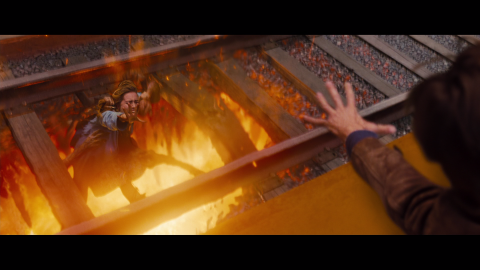The Swoon and Doom of DRAG ME TO HELL

DRAG ME TO HELL
These notes on Sam Raimi's Drag Me to Hell (2009) were written by WUD Film’s Kristen Johnson-Salazar. A 35mm print of Drag Me to Hell will be screened in 4070 Vilas Hall on Saturday, April 21 at 7 p.m. The screening will be followed by a discussion with Drag Me to Hell's cinematographer and UW alum Peter Deming. Admission is free!
By Kristen Johnson-Salazar
There is something utterly fascinating about doomed characters who you, as the viewer, hope will defeat the evil presence looming over their heads, while also wanting to watch the horrible misfortunes that invade their lives. However, like the genre of horror-comedy itself, there must be a balance to the schadenfreude. Evil Dead II and The Cabin in the Woods exemplify this effect of watching horrid events transpire, while never forgetting their comically outlandish and goofy nature.
Sam Raimi understands this balance. For many of the films he directs, he mixes horror and comedy to play with the audience’s expectations. Raimi has written and directed well-known cult classics, many of them synonymous with the horror-comedy genre. This is what makes Drag Me to Hell both a return to form as well as a contemporary Raimi shock, schlock, and fun film. The story was written right after 1993’s Army of Darkness; however, the idea was shelved while Raimi directed the Spider-Man films. Finally, when the third and final film in that franchise was released, Raimi dug up the screenplay titled The Curse, which would become Drag Me to Hell.
Drag Me to Hell is also a return for cinematographer Peter Deming, who previously worked with Raimi on 1987’s Evil Dead II. Since then, Deming continued working in a number of genres with other notable directors, including Wes Craven (Scream 2), David O. Russell (I Heart Huckabees) and, most notably, David Lynch (Lost Highway, Mulholland Dr.). In the last decade, Deming again reunited with Raimi for Oz the Great and Powerful and with Lynch for his revival of the Twin Peaks series. As a cinematographer, Deming builds lived-in worlds, even when those worlds are filled with supernatural and frightening beings. From all the films Deming has worked on, it is incredible to see his recognition of horror tropes and how he deconstructs and reorders them on screen. In Drag Me to Hell, Raimi and Deming play with our assumptions of a scene and explore why we care about characters like Christine (Alison Lohman), and why we want to see them overcome their doom. In his production notes, Deming writes, “From the beginning, Sam and I talked about being with her as much as we subjectively could throughout the film. We stayed right on Christine’s face a lot of the time. We covered scenes and gave her extra-tight close-ups, because we want the audience to be in her place.” This movie wouldn’t work without us caring about Christine.
Throughout the film, we, the audience, remain focused on Christine. It is almost inconceivable that her initially bright world edges into one of darkness and decay. Deming wanted realistic lighting to be used for this transformation. Even the scenes involving the garage or street lamps were never given corrected bulbs to add to this “heightened sense of realism.” This realistic lighting shifts to darkness as Christine descends into the world of the supernatural, often shown in canted angles and close-ups. Deming recounted that, “Sam loves B-movie stuff. He really embraces the wind out of nowhere and the camera shaking, and the inventive, interactive lighting. He eats that up.” These features can be seen during the séance, one of many moments when Christine tries to get her curse lifted. The séance scene is as fantastic as it is wild. It’s a visual and audio overload that calls back to bonkers scenes of Evil Dead II, when all things that could go wrong do, in comedic fashion, of course.
Since it results from an everyday occurrence for any loan officer, the horror she suffers through seems hyperbolic, yet it fits perfectly within Raimi and Deming’s hell. Christine’s ordinary nature makes her trial of escape that much more impactful and heart wrenching. If you are familiar with Raimi’s work, you have noticed that he loves the everyday person who has to become extraordinary through the supernatural. Like Evil Dead’s Ash Williams and Spider-Man’s Peter Parker, Christine finds herself in unfortunate circumstances and must fight to get her life back to the status quo; however, once it’s changed, it will never be the same. This returns us to the idea of the doomed character. How do we care for Christine, while knowing that her doomed fate is all but sealed? She doesn’t give up and continues to do everything that is possible and at her disposal. To the audience’s dismay, her actions even become extreme, hoping to lift the curse. But is that even enough?
Drag Me to Hell, like much of Raimi and Deming’s work, is visually off the walls and bombastically hilarious. It is everything you expect and more from a Raimi movie with this title, and it never lets you forget it.
